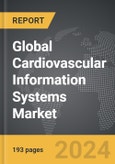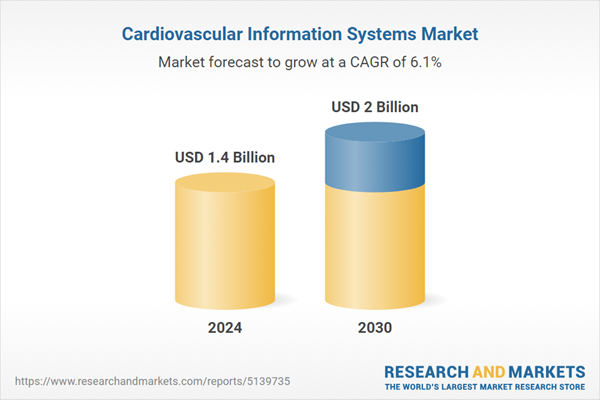Global Cardiovascular Information Systems Market - Key Trends and Drivers Summarized
What Are Cardiovascular Information Systems and Why Are They Indispensable?
Cardiovascular Information Systems (CVIS) are critical to the modernization of cardiovascular healthcare, providing a comprehensive platform for collecting, managing, and analyzing cardiovascular data. These systems integrate various sources of patient information, such as diagnostic images, test results, clinical reports, and procedural data, into one accessible interface. This allows healthcare providers, including cardiologists, radiologists, and technicians, to easily access and share information necessary for diagnosing and treating cardiovascular conditions. CVIS also streamlines workflows in hospitals and clinics by reducing the need for physical paperwork and manual data entry, which in turn enhances the accuracy and speed of cardiovascular diagnostics and care planning. In an era where cardiovascular diseases are one of the leading causes of death globally, the role of CVIS in organizing and presenting critical patient data is indispensable for improving patient outcomes and operational efficiency in healthcare settings. The real value of CVIS lies in its ability to integrate and manage data from a wide array of cardiovascular tests, including echocardiograms, electrocardiograms (ECGs), angiograms, and stress tests. These systems provide healthcare professionals with immediate access to both real-time and historical patient data, ensuring that they can make informed, data-driven decisions regarding treatment plans. By consolidating disparate types of cardiovascular data into a single platform, CVIS eliminates inefficiencies caused by fragmented data and enhances the collaboration among different medical departments.How Has Technology Transformed Cardiovascular Information Systems?
Advances in technology have significantly expanded the capabilities of Cardiovascular Information Systems, enhancing their functionality and making them more user-friendly for healthcare professionals. One of the most transformative developments has been the integration of CVIS with hospital-wide Electronic Health Records (EHR), allowing cardiovascular data to be easily shared across departments, ensuring a seamless flow of patient information. This integration minimizes errors caused by manual data entry and reduces the risk of misdiagnosis due to incomplete or inaccessible patient records. Moreover, CVIS now includes advanced data analytics tools, which enable clinicians to quickly analyze large datasets and extract actionable insights. These tools often incorporate artificial intelligence (AI) and machine learning algorithms, which can detect subtle patterns in cardiovascular data that might be missed by human analysis alone. For instance, AI can predict the likelihood of adverse cardiac events, allowing for preventive measures to be implemented more effectively. Furthermore, modern CVIS platforms have embraced cloud technology, allowing for secure, remote access to cardiovascular data. This is particularly useful in facilitating telemedicine and remote consultations, which have become more prevalent in the wake of the COVID-19 pandemic. Physicians can now access cardiovascular data and diagnostic results from any location, enabling more flexible care delivery, especially for patients in rural or underserved areas. The rise of mobile health (mHealth) solutions has further improved the versatility of CVIS, as doctors can monitor patients' heart conditions in real-time through wearable devices that sync data directly into the system. These technological innovations have not only enhanced the accuracy and timeliness of cardiovascular care but also made it more personalized, allowing for tailored treatment plans based on real-time data.What Are the Emerging Trends in Cardiovascular Information Systems?
Several emerging trends are shaping the future of Cardiovascular Information Systems, driven by the need for better patient outcomes and the healthcare industry's shift toward data-driven decision-making. One of the key trends is the increasing use of AI and machine learning within CVIS to improve diagnostic accuracy and predictive analytics. These technologies can analyze vast amounts of cardiovascular data and identify patterns that might indicate the early stages of heart disease, allowing for timely interventions and reducing the likelihood of severe complications. Additionally, AI-powered CVIS systems can help in automating administrative tasks such as scheduling, billing, and reporting, freeing up more time for healthcare providers to focus on patient care. Another trend is the rise of interoperable systems, where CVIS platforms can seamlessly connect with other healthcare information systems, enabling a holistic view of the patient's overall health. This level of integration is particularly important in large healthcare networks and hospital systems, where multiple departments and specialists are involved in a patient's care. Interoperability ensures that cardiovascular data is not siloed but rather is part of a larger, interconnected system that improves clinical decision-making. Additionally, the growing demand for remote patient monitoring has fueled the development of CVIS platforms that support real-time data from wearable devices such as smartwatches and portable ECG monitors. This allows cardiologists to track the heart health of their patients outside the clinical environment, providing continuous monitoring for those at risk of heart attacks or arrhythmias. Lastly, the shift toward value-based care, where the emphasis is on improving patient outcomes while reducing healthcare costs, has encouraged hospitals to adopt CVIS to optimize their operations, reduce redundancies, and ensure that care is timely and evidence-based.What Are the Factors Behind the Growth of the Cardiovascular Information Systems Market?
The growth in the Cardiovascular Information Systems market is driven by several factors directly linked to advancements in technology, changing healthcare practices, and evolving patient needs. One of the key drivers is the increasing prevalence of cardiovascular diseases, which are the leading cause of death worldwide. As the number of patients with heart conditions rises, so does the demand for efficient systems that can manage the large volumes of cardiovascular data generated from diagnostic tests, imaging, and patient monitoring. Healthcare providers are increasingly turning to CVIS platforms to streamline their workflows and ensure that critical data is readily accessible for making timely and informed treatment decisions. Another factor contributing to the market's growth is the integration of AI and predictive analytics tools within CVIS, which allow for more precise and proactive care. These advanced tools enable healthcare professionals to detect potential issues early on, improving patient outcomes and reducing costly hospital readmissions. In addition to technological advancements, the shift toward personalized and remote care is also fueling the demand for CVIS systems. Patients are increasingly expecting more tailored healthcare experiences, and CVIS platforms help meet this demand by enabling healthcare providers to customize treatment plans based on individual cardiovascular data. The rise of telemedicine has further highlighted the need for cloud-based CVIS platforms that support remote consultations and real-time patient monitoring. Additionally, healthcare organizations are prioritizing interoperability, seeking CVIS systems that can seamlessly integrate with existing EHRs and other clinical applications. This need for comprehensive, interoperable solutions is driving the adoption of CVIS, as they enable a more connected and efficient healthcare ecosystem. Lastly, the increasing focus on regulatory compliance and the push for value-based care have led to higher adoption rates of CVIS, as these systems help healthcare providers meet quality benchmarks and improve the cost-effectiveness of cardiovascular care.Report Scope
The report analyzes the Cardiovascular Information Systems market, presented in terms of market value (USD). The analysis covers the key segments and geographic regions outlined below.- Segments: Mode of Operation (Web-Based, Cloud, Onsite); Application (Catheterization Lab CVIS Solutions, Electrocardiography, Electrocardiogram, Electrophysiology, Other Applications); End-Use (Hospitals, Diagnostic Centers).
- Geographic Regions/Countries: World; United States; Canada; Japan; China; Europe (France; Germany; Italy; United Kingdom; and Rest of Europe); Asia-Pacific; Rest of World.
Key Insights:
- Market Growth: Understand the significant growth trajectory of the Catheterization Lab CVIS Solutions Application segment, which is expected to reach US$844.6 Million by 2030 with a CAGR of 6.6%. The Electrocardiography Application segment is also set to grow at 6% CAGR over the analysis period.
- Regional Analysis: Gain insights into the U.S. market, valued at $395.8 Million in 2024, and China, forecasted to grow at an impressive 5.6% CAGR to reach $316.2 Million by 2030. Discover growth trends in other key regions, including Japan, Canada, Germany, and the Asia-Pacific.
Why You Should Buy This Report:
- Detailed Market Analysis: Access a thorough analysis of the Global Cardiovascular Information Systems Market, covering all major geographic regions and market segments.
- Competitive Insights: Get an overview of the competitive landscape, including the market presence of major players across different geographies.
- Future Trends and Drivers: Understand the key trends and drivers shaping the future of the Global Cardiovascular Information Systems Market.
- Actionable Insights: Benefit from actionable insights that can help you identify new revenue opportunities and make strategic business decisions.
Key Questions Answered:
- How is the Global Cardiovascular Information Systems Market expected to evolve by 2030?
- What are the main drivers and restraints affecting the market?
- Which market segments will grow the most over the forecast period?
- How will market shares for different regions and segments change by 2030?
- Who are the leading players in the market, and what are their prospects?
Report Features:
- Comprehensive Market Data: Independent analysis of annual sales and market forecasts in US$ Million from 2024 to 2030.
- In-Depth Regional Analysis: Detailed insights into key markets, including the U.S., China, Japan, Canada, Europe, Asia-Pacific, Latin America, Middle East, and Africa.
- Company Profiles: Coverage of players such as Agfa HealthCare, Cerner Corporation, Digisonics, Inc., Fujifilm Medical Systems USA, Inc., GE Healthcare and more.
- Complimentary Updates: Receive free report updates for one year to keep you informed of the latest market developments.
Some of the 44 companies featured in this Cardiovascular Information Systems market report include:
- Agfa HealthCare
- Cerner Corporation
- Digisonics, Inc.
- Fujifilm Medical Systems USA, Inc.
- GE Healthcare
- LUMEDX Corporation
- McKesson Corporation
- Merge Healthcare, Inc.
- Philips Healthcare
- Siemens Healthineers
This edition integrates the latest global trade and economic shifts into comprehensive market analysis. Key updates include:
- Tariff and Trade Impact: Insights into global tariff negotiations across 180+ countries, with analysis of supply chain turbulence, sourcing disruptions, and geographic realignment. Special focus on 2025 as a pivotal year for trade tensions, including updated perspectives on the Trump-era tariffs.
- Adjusted Forecasts and Analytics: Revised global and regional market forecasts through 2030, incorporating tariff effects, economic uncertainty, and structural changes in globalization. Includes historical analysis from 2015 to 2023.
- Strategic Market Dynamics: Evaluation of revised market prospects, regional outlooks, and key economic indicators such as population and urbanization trends.
- Innovation & Technology Trends: Latest developments in product and process innovation, emerging technologies, and key industry drivers shaping the competitive landscape.
- Competitive Intelligence: Updated global market share estimates for 2025, competitive positioning of major players (Strong/Active/Niche/Trivial), and refined focus on leading global brands and core players.
- Expert Insight & Commentary: Strategic analysis from economists, trade experts, and domain specialists to contextualize market shifts and identify emerging opportunities.
Table of Contents
Companies Mentioned (Partial List)
A selection of companies mentioned in this report includes, but is not limited to:
- Agfa HealthCare
- Cerner Corporation
- Digisonics, Inc.
- Fujifilm Medical Systems USA, Inc.
- GE Healthcare
- LUMEDX Corporation
- McKesson Corporation
- Merge Healthcare, Inc.
- Philips Healthcare
- Siemens Healthineers
Table Information
| Report Attribute | Details |
|---|---|
| No. of Pages | 193 |
| Published | December 2025 |
| Forecast Period | 2024 - 2030 |
| Estimated Market Value ( USD | $ 1.4 Billion |
| Forecasted Market Value ( USD | $ 2 Billion |
| Compound Annual Growth Rate | 6.1% |
| Regions Covered | Global |









